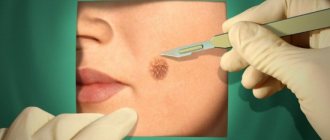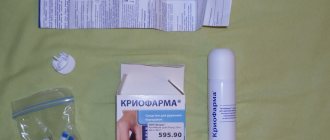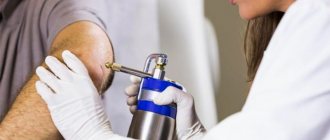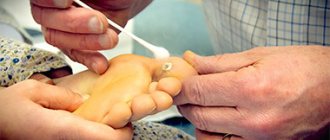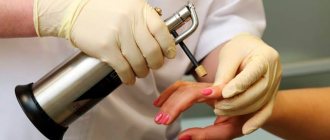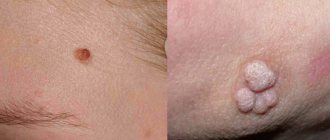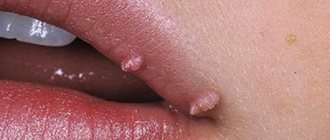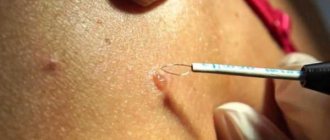A wart is a skin lesion caused by HPV (papillomavirus). The formation may begin to bleed, change color, increase in size, spread throughout the body, and cause pain and discomfort. If it is often subjected to injury, friction and cuts, the risk of malignant degeneration increases. Therefore, when the tumor is located in places that are dangerous for injury, it is recommended to remove it in any safe way. Most often, clinics offer wart removal with laser or nitrogen - which is better to choose? The procedures differ in the principle of impact, cost, degree of effectiveness, as well as indications and contraindications. What procedure a dermatologist will recommend in your case depends on the individual characteristics of your body.
Causes of papillomas
One of the most likely causes of the appearance of epithelial neoplasms is the human papillomavirus (HPV), which enters the body from the outside and lies dormant until a certain moment. Both men and women are susceptible to the appearance of neoplasms; the age criterion is also not particularly important. Most often, HPV enters the body of a healthy person through unprotected sexual contact, through microtrauma on the skin, or through failure to comply with personal hygiene rules. In some cases, the human papillomavirus is transmitted from an infected mother to her newborn. Papillomas are localized almost everywhere: on the face, abdomen, in the groin and armpits, on the neck, mucous membranes, etc.
Factors leading to virus activation
HPV can remain inactive for as long as desired, but there are certain factors that provoke its activity:
- bad habits;
- impaired metabolism;
- weakened immune system;
- hypothermia;
- atherosclerosis;
- nervous or physical exhaustion;
- antimicrobial drug abuse;
- pathologies of the digestive system;
- long-term use of hormonal contraceptives.
It is worth noting that HPV cannot be cured, it can only be driven into a state of stable remission by strengthening the immune system and eliminating provoking factors.
Advantages and disadvantages of laser systems
Today, several types of devices are used for treatment:
- CO2 laser: using infrared radiation, the wavelength of which is 10600 mn, the liquid is evaporated and the spine is destroyed. The disadvantage of this method is that it can damage the skin and cause scarring.
- Pulsed laser: affects oxyhemoglobin, destroying the capillaries of the wart. The procedure is the least painful and there are practically no scars left.
- Erbium laser: destruction of the spine is carried out by infrared rays, but their length, compared to the installation of type 1, is shorter and is about 2500 mn.
Indications for removal
When epithelial tumors do not cause physical discomfort, they are rarely removed. Reasons for surgical intervention may include the following factors:
- the tumor causes pain when wearing shoes or clothes;
- uncontrolled growth of growths is observed;
- darkening of the papilloma or its rapid growth;
- the papilloma bleeds or becomes inflamed.
You may be interested in: How to get rid of red dots after hair removal
Signs of a spine on the leg
Most often, the spines are located in places where the foot rubs against the shoe, or on the pads of the toes. Signs of the presence of a spine include the appearance of pain while walking. Plantar warts tend to grow into deeper layers of the skin.
Spines are quite resistant to various treatment methods. They are single and multiple. The spines may darken and become rough as they grow. Deep forms of plantar warts are characterized by the presence of a peculiar crater-like depression located in the middle of the body of the wart.
Laser removal of papillomas
Removal of epithelial tumors with a laser is a fairly quick and easy-to-perform procedure. Its advantages include:
- minimal risk of injuring healthy tissue;
- no pain;
- Only local anesthesia is required;
- short rehabilitation period;
- does not require hospitalization;
- low chance of infection since there is no contact with blood or open wound;
- rapid healing, as it disinfects and cauterizes the wound;
- short intervention time;
- low probability of relapse;
- absence of scars and cicatrices.
Preparation for the procedure
Despite the simplicity of implementation, laser removal of papillomas is still a surgical intervention, therefore, before proceeding with direct treatment, the patient must undergo general blood and urine tests, blood tests for hormones, allergens and biochemistry. In many cases, biomaterial is taken for a biopsy to determine the type of HPV. 10 - 14 days before the manipulation, you should avoid medicinal baths, tanning, including in a solarium, and applying cosmetics to the affected area. If the papilloma interferes with normal activities, you should cover it with a band-aid.
How does laser cauterization work?
Before starting the manipulation, the specialist will treat the area affected by the laser with an antiseptic solution and local anesthetic, and then begin direct cauterization. During the manipulation, the intracellular contents are evaporated, layer by layer, destroying the pathological growth. The place where the papilloma was turns into a bloodless wound. In some cases, after cauterization, the patient notices slight redness at the removal site, feels itching or minor pain. In most cases, all side effects disappear within 2-3 days.
Contraindications for laser removal
Despite its high efficiency and safety, the technique has a number of contraindications:
- pregnancy, with the exception of cases where there are growths in the area of the vulva or labia, since they can become a source of infection for the baby;
- lactation period, since hormonal changes in the body of a nursing woman can slow down the healing process;
- disorders of the immune system, including AIDS;
- high concentration of glucose in the blood, including in diabetes mellitus;
- blood clotting disorder;
- oncology at stages 3 and 4;
- epilepsy with uncontrolled seizures;
- period of exacerbation of viral and infectious diseases;
- herpes;
- photodermatosis.
Advantages and disadvantages of the method
There are many folk methods for removing papillomas. People try to remove warts at home with acidic or alkaline solutions prepared in a pharmacy: celandine extract, vinegar, chalk, onion juice.
It is worth understanding that such processing is a useless and risky exercise. Such actions can lead to serious consequences. It is impossible to get rid of a problem without looking at its root.
Modern medicine offers techniques that have proven their effectiveness:
- Cryotherapy – cauterization with nitrogen.
- Laser therapy – laser burning.
- Electrocoagulation is a surgical method.
Unlike other procedures, removing spines and other formations with liquid nitrogen is inexpensive and effective. High-precision equipment acts specifically on the source of infection, without touching healthy areas of the skin, shortening the recovery period, without leaving scars.
Like any other method, deep tissue freezing has its contraindications:
- nervous system disorders;
- epilepsy;
- allergic reactions to nitrogen;
- hypertension;
- pregnancy;
- infectious diseases and high fever;
- additional dermatological diseases.
Removal of papillomas with liquid nitrogen
The effect of liquid nitrogen on the skin is called cryodestruction. During this procedure, the damaged area is deep frozen. The epithelial neoplasm is exposed to liquid nitrogen for 15-30 seconds, having a temperature of about – 196C, at this time the papilloma thickens and turns white, and after the end of the session the area around it turns red, and slight swelling may be observed. Exposure to liquid nitrogen deprives the papilloma cells of nutrition, and it dies. After 2-5 hours, a bubble appears at the site of nitrogen exposure, which resolves on its own, and after about 7 days, a crust forms at the site of the growth, which also moves away from the skin on its own within a week. Cryodestruction requires mandatory anesthesia on the affected areas.
Preparation for the procedure
Like any surgical intervention, cryodestruction requires certain preparation:
- exclude the possibility that the neoplasm is malignant;
- stop taking medications that reduce blood viscosity 5-7 days before;
- wait for a state of remission if there are chronic or acute viral diseases.
Advantages of the technique
The main advantage of cauterizing papillomas with liquid nitrogen is that the rejection of non-viable tissue does not occur immediately; it still remains in place for some time, providing biological natural protection to damaged areas of the epidermis. Healing occurs quickly and painlessly. In addition, the advantages of removing papillomas with liquid nitrogen are:
- high efficiency of the technique;
- lack of preparation;
- performed on an outpatient basis;
- low risk of bleeding;
- minimal exposure time;
- relatively low price.
Contraindications to cryodestruction
Removal of skin tumors using cryodestruction has a number of contraindications:
- pregnancy;
- pronounced hypertension;
- high sensitivity to nitrogen;
- acute colds and viral diseases;
- epilepsy;
- skin rashes in the area affected by the applicator.
Pros and cons of cryodestruction
The advantages include:
- speed of manipulation;
- ease of implementation and efficiency;
- lack of preoperative preparation;
- minimal risks of postoperative scar tissue formation;
- the ability to prevent bleeding, both during the procedure and after it.
In addition, the advantage of cryodestruction is the affordability of the procedure.
There are significantly fewer disadvantages of cryodestruction.
The disadvantages of removing spines using liquid nitrogen include:
- difficulties in controlling the depth of action of nitrogen, which may lead to the need for another freezing session;
- the duration of the recovery period, relative to the structure of the epidermis;
- slight discomfort during the procedure;
- frequency of postoperative wound surface treatment;
- inability to conduct laboratory histological analysis of the removed tumor.
It is important to note that the removal of spines using cryodestruction, as well as adherence to an individual approach to each patient and the professionalism of the medical staff, makes this method of treatment the most preferable in comparison with other methods.
— Lack of blood during cryodestruction.
— Possibility of carrying out in relation to children.
— Inadmissibility of controlling the depth of nitrogen exposure. This means that if the wart is large, several cryodestruction procedures may be necessary to completely eliminate the growth.
As you can see, cauterization with nitrogen and laser exposure have both positive and negative sides. There is no clear answer to the question of which is better. Only together with a doctor can you understand which method of getting rid of the growth is right for you.
Main contraindications
It is prohibited to use this method of removing warts if:
- Pregnancy.
- The presence of an acute infectious disease.
- Exacerbation of chronic diseases.
- Skin cancer.
- Epilepsy.
- Allergies to cold.
- High blood pressure.
The process of removing warts with laser or nitrogen must be carried out by a qualified doctor. The cost of the procedure depends on the clinic or hospital where the therapy was performed. The size of the tumor is no less important.
Is it possible to avoid relapses?
Since warts are viral in nature, it is impossible to guarantee the absence of relapses using any method of removing them . Infected cells may remain in the affected area. To reduce the risk of the formation of new growths, general and local antiviral therapy is carried out.
Note! The risk of developing new warts is higher the older the patient and the lower his immune status. There is no dependence on the method of removing warts.
How to carry out the procedure
First, the patient must be examined by an oncologist-dermatologist. The patient is placed on the operating chair. Next, you should expose the necessary areas of the skin (on which the warts are located). The specialist treats the skin using antiseptics. If necessary, the patient is given an anesthetic drug. After this, a laser is aimed at the wart. All that will remain of the wart is a crust. It is not advisable to wash the affected area with water after the procedure. The crusts disappear on their own after a week. There is no need to worry if there is a light mark left on the skin. After some time it will disappear. Experts recommend applying sunscreen to the skin (where the wart was).
When should you sound the alarm?
You can live with a wart all your life if it does not interfere or is not visible. But there are such symptoms, if you notice them, it is important to promptly consult a doctor:
- Bleeding.
– Darkening of the wart, its enlargement.
– Spread of papillomas throughout the body.
– Painful sensations when touched.
Most often, a person goes to the hospital to eliminate warts on his hands. A photo of papilloma on the upper extremities can be seen below. Also in this article you will find pictures before and after removing the growth.
